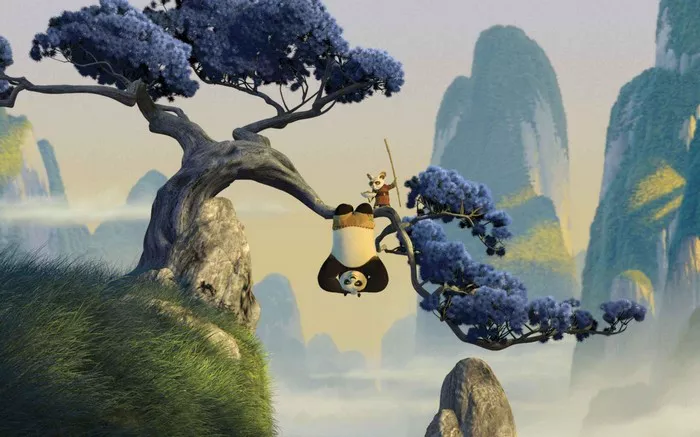The Kung Fu Panda franchise has become a beloved staple of animated cinema, captivating audiences with its blend of humor, heart, and martial arts action. Set in a fantastical version of ancient China, the films follow the adventures of Po, a bumbling panda who dreams of becoming a kung fu master. With its richly detailed settings, vibrant characters, and nods to Chinese culture, many viewers assume that Kung Fu Panda is a product of China. However, the question remains: is Kung Fu Panda truly Chinese?
A Global Collaboration: Behind the Scenes of Kung Fu Panda
Origins of the Franchise: DreamWorks Animation’s Vision
To understand the cultural influences behind Kung Fu Panda, it’s essential to delve into the origins of the franchise. DreamWorks Animation, the studio behind the films, is an American company known for producing a wide range of animated features. The concept for Kung Fu Panda was developed by directors John Stevenson and Mark Osborne, who drew inspiration from their love of martial arts films and Chinese culture.
While DreamWorks Animation spearheaded the creative vision for Kung Fu Panda, the production process was a collaborative effort involving artists, animators, and writers from around the world. The studio worked closely with a team of cultural consultants, including Chinese martial arts experts and historians, to ensure authenticity and respect for Chinese culture throughout the filmmaking process.
Cultural Immersion: Authenticity in Kung Fu Panda
Setting the Stage: A Glimpse into Ancient China
One of the most striking aspects of Kung Fu Panda is its meticulously crafted setting, which transports viewers to a vibrant and immersive version of ancient China. From the bustling streets of the Valley of Peace to the majestic Jade Palace, the film’s locations are rich in detail and steeped in Chinese aesthetics.
The filmmakers drew inspiration from a variety of sources, including traditional Chinese architecture, landscape painting, and martial arts mythology, to create a world that feels both authentic and fantastical. Every aspect of the film’s design, from the intricate costumes to the ornate temples, reflects a deep respect for Chinese culture and heritage.
Character Development: Embracing Diversity
Central to the success of Kung Fu Panda are its diverse and memorable characters, each of whom brings their own unique perspective and personality to the story. While Po, the lovable panda protagonist, may not fit the traditional mold of a Chinese hero, his journey of self-discovery and acceptance resonates with audiences around the world.
The supporting cast of Kung Fu Panda is equally diverse, representing a wide range of cultural backgrounds and martial arts disciplines. From the wise and stoic Master Shifu to the fiery and passionate Tigress, each character embodies different aspects of Chinese culture and philosophy, adding depth and nuance to the film’s narrative.
Cultural Appropriation vs. Appreciation: Debating the Legacy of Kung Fu Panda
Criticism and Controversy: Addressing Cultural Sensitivities
Despite its widespread acclaim, Kung Fu Panda has not been immune to criticism regarding its portrayal of Chinese culture. Some viewers have raised concerns about cultural appropriation, arguing that the film’s use of Chinese imagery and themes reinforces stereotypes and fails to accurately represent the complexities of Chinese history and society.
In particular, the character of Po, a clumsy and bumbling panda who becomes a kung fu master through sheer luck, has been criticized for perpetuating the “white savior” trope, in which a non-Asian protagonist is positioned as the hero of a story set in Asia. Critics argue that this narrative diminishes the agency and contributions of Chinese characters within the film.
Celebrating Cultural Exchange: Finding Common Ground
Despite these criticisms, many fans of Kung Fu Panda argue that the film should be celebrated for its efforts to celebrate and honor Chinese culture. While the characters and story may be fictional, the filmmakers’ commitment to authenticity and respect shines through in every frame, creating a world that feels both familiar and fantastical.
Moreover, Kung Fu Panda has played a significant role in introducing audiences around the world to Chinese culture and martial arts. Through its vibrant animation, engaging characters, and thrilling action sequences, the film has sparked a renewed interest in Chinese history, philosophy, and traditions among viewers of all ages.
Conclusion: The Global Legacy of Kung Fu Panda
In conclusion, the question of whether Kung Fu Panda is truly Chinese is a complex one that defies easy categorization. While the film may have been produced by an American studio and feature a diverse cast of characters, its roots are undeniably grounded in Chinese culture and mythology.
Through its meticulous attention to detail, vibrant visual storytelling, and universal themes of courage, friendship, and self-discovery, Kung Fu Panda has transcended cultural boundaries to become a beloved and iconic franchise enjoyed by audiences around the world. Whether viewed as a celebration of Chinese culture or a case of cultural appropriation, there is no denying the enduring impact and legacy of Kung Fu Panda on global animation and popular culture.

